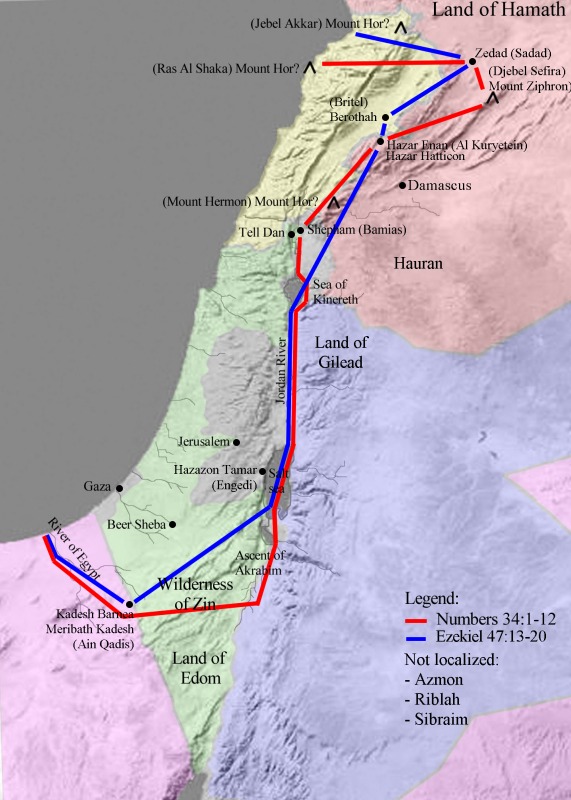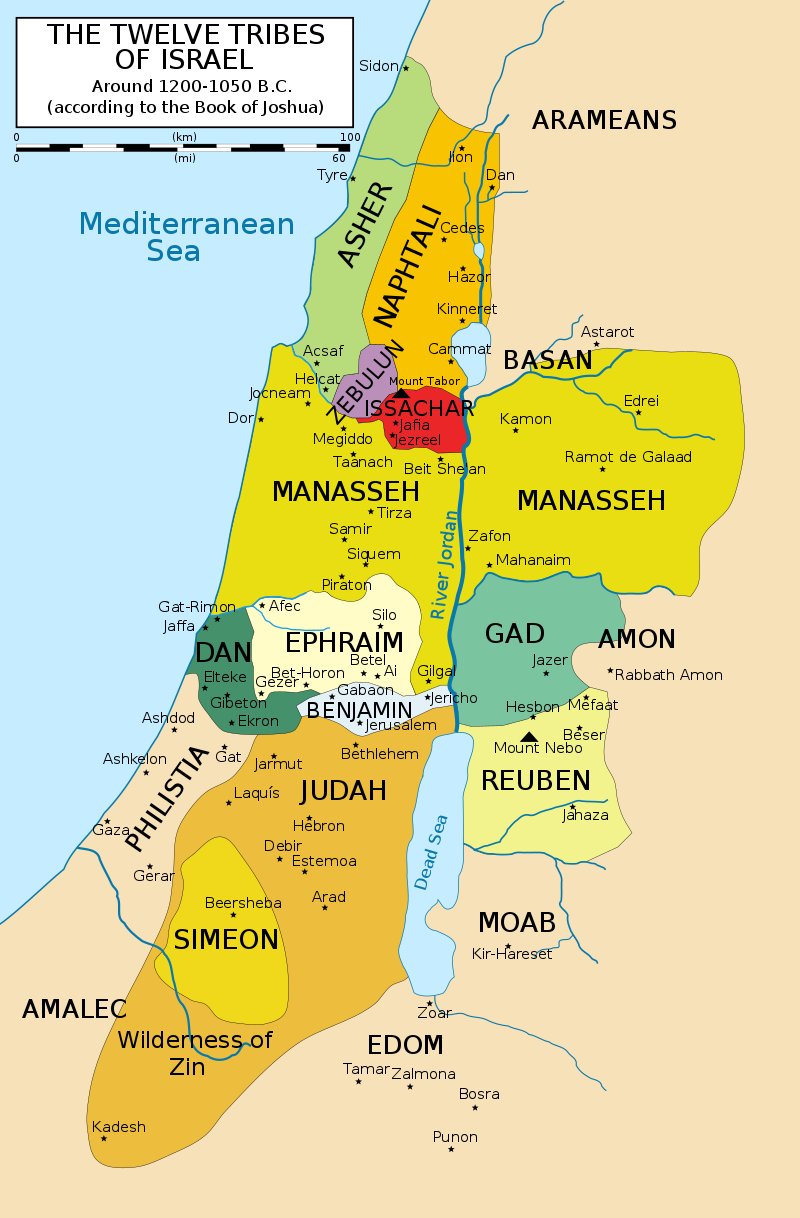Who and what is…
Canaan and what is The Promised Land?
Hebrew: כְּנַעַן —transliteration: Kna'an —occurrences:
This is the name of a biblical man and a land that belonged to descendants of that man, and later became The Promised Land of Abraham’s descendants.
-
Canaan, son of Ham
Canaan is the 4th son of Ham (Genesis 10:6) and a grandson of Noah.
His descendants were under a curse due to the transgression of his father (Gen. 9:22-27).
Cursed
When Noah awoke from his wine, he knew what his youngest son had done to him. So he said,
“Cursed be Canaan;
A servant of servants
He shall be to his brothers.”He also said,
“Blessed be the Lord,
The God of Shem;
And let Canaan be his servant.
May God enlarge Japheth,
And let him dwell in the tents of Shem;
And let Canaan be his servant.” —Genesis 9:24-27 NASBCanaan’s eldest son Zidon (Sidon) was the father of the Sidonians and Phoenicians. He had 11 sons, who were the founders of as many tribes (Genesis 10:15-18).
Canaan fathered Sidon, his firstborn, and Heth, the Jebusite, the Amorite, the Girgashite, the Hivite, the Arkite, the Sinite, the Arvadite, the Zemarite, and the Hamathite; and afterward the families of the Canaanite were spread abroad. The territory of the Canaanite extended from Sidon going toward Gerar, as far as Gaza; and going toward Sodom and Gomorrah, Admah, and Zeboiim, as far as Lasha. —Genesis 10:15-19 NASB
Relatives of Canaan
- Grandfather: Noah
- Father: Ham
- Mother: not named in Scripture
- Brothers: • Cush • Mizraim • Put (Phut)
- • Sidon • Heth (There may have been others, but theses are the only ones mentioned in Scripture.)
- Descendants: • Amorites • Arkites • Arvadites • CANAANITES • the Girgashites • Hamathites • Hivites • Jebusites • Sinites • Zemarites
-
Canaan, the land
This area derived its name from the man above.
The name as first used by the Phoenicians denoted only the maritime plain on which Sidon was built on the coast of the Mediterranean. But in the time of Moses and Joshua, it denoted the whole country to the west of the Jordan River and the Dead Sea (Deuteronomy 11:30). In Joshua 5:12 the Septuagint read, “land of the Phoenicians,” instead of “land of Canaan.”
The name signifies “the lowlands,” as distinguished from the land of Gilead on the east of Jordan, which was a mountainous district. The extent and boundaries of Canaan are fully set forth in different parts of Scripture (Genesis 10:19; 17:8; Numbers 13:29; 34:8).
Probable borders of The Promised Land, marked in RED as defined by Numbers 34:1–12, and in BLUE as defined by Ezekiel 47.Author: EmmanuelM (2007). Licensed by CC BY-SA 3.0.The Promised Land
And Yahweh said to Abram,
“Go forth from your land,
And from your kin
And from your father’s house,
To the land which I will show you;
And I will make you a great nation,
And I will bless you,
And make your name great;
And so you shall be a blessing;
And I will bless those who bless you,
And the one who curses you I will curse.
And in you all the families of the earth will be blessed.” —Genesis 12:1-3 LSBThe land of Canaan was promised by God to the descendants of Abraham (Genesis 12:7) and is thus referred to as The Promised Land.
Then the Lord appeared to Abram and said, “To your descendants I will give this land.” And there he built an altar to the Lord, who had appeared to him. —Genesis 12:7 NKJV
“The Lord, the God of heaven, who took me from my father’s house and from the land of my birth, and who spoke to me and who swore to me, saying, ‘To your descendants I will give this land,’… —Genesis 24:7 NASB excerpt
It is called “The Land of Promise” in Hebrews 11:9.
As the Israelites were about to enter into this land, God promised,
But the land into which you are about to cross to possess it, a land of hills and valleys, drinks water from the rain of heaven, a land for which Yahweh your God cares; the eyes of Yahweh your God are always on it, from the beginning even to the end of the year.
“And it will be that, if you listen obediently to my commandments which I am commanding you today, to love Yahweh your God and to serve Him with all your heart and all your soul, that I, Yahweh, will give the rain for your land in its season, the early and late rains, that you may gather in your grain and your new wine and your oil. And I will give grass in your fields for your cattle, and you will eat and be satisfied. Beware lest your hearts be deceived, and you turn away and serve other gods and worship them, and the anger of Yahweh will be kindled against you, and He will shut up the heavens so that there will be no rain and the ground will not yield its fruit; and you will perish quickly from the good land which Yahweh is giving you.” —Deuteronomy 11:10-17
Later this land was known as “The Land of the Hebrews” (Genesis 40:15). It is also called “The Land of the LORD,” “The Land of Jehovah (YHWH)” (Hosea 9:3; Psalm 85:1), and “The Holy land” (Zechariah 2:12). It is also called “The Land of Israel” (1 Samuel 13:19), and “The Land of Judah” (Isaiah 19:17).
The approximate location and boundaries of the 12 landed Israelite tribes, based on records in the Book of Joshua. This, and more, was The Promised Land given by God to the descendants of Israel, the grandson of Abraham. The full extent of the Canaanite land promised was never acquired, due to the repeated disobedience of the Israelites during the their commanded conquest of this very idolatrous, heathen land, after the Exodus from slavery in Egypt and the following 40 years of Divine punishment wandering in the wilderness, before Joshua and the living descendants were allowed to enter the land, following the death of Moses.The Book of Joshua, confirms that at the time Joshua divided up the land between the 12 tribes, God’s promise was completed.
So Yahweh gave Israel all the land which He had sworn to give to their fathers, and they possessed it and lived in it. … Not one promise of the good promises which Yahweh had promised to the house of Israel failed; all came to pass. —Joshua 21:43, 45 LSB
Some tribes failed to hold of their land, but it was eventually mostly conquered by King David, and was ruled over also by his son King Solomon (2 Samuel 8; 1 Chronicles 18; 1 Kings 4:1; 1 Kings 4:21). During the reign of King Solomon, Israel had control of most of The Promised Land.
“Borders of the Promised Land”During the Millennial Period, Jerusalem and The Promised Land will be central in Christ’s Earthly kingdom.
Canaanite languages
The people of the ancient land of Canaan primarily spoke a Semitic language of which there were various dialects and other variations.
The language of the Canaanites and of the Hebrews was substantially the same. This is seen from the fragments of the Phoenician language which still survive, which show the closest analogy to Hebrew.
The cuneiform writing of Babylon, as well as the Babylonian language, was taught in the Canaanite schools, and the clay tablets of Babylonian literature were stored in the Canaanite libraries.
Even the Babylonian divinities were borrowed by the Canaanites.
- About idolatry and false gods in the Bible
- About idols in the Bible
- What are the high places referred to in the Bible?
Languages of the land of Canaan include:
- Canaanite
- Amalekite
- Ammonite
- Hebrew
- Moabite
- Edomite
- Ekronite
- Phoenician
- Punic, aka Phoenicio-Punic or Carthaginian, an offshoot of the Phoenician language—used by Semitic people who migrated from Phoenicia
- Syriac, aka Armaic or Aramean
- Sutean —language of the Suteans, a nomadic Semitic people who lived throughout the Levant, Canaan and Mesopotamia, specifically in an ancient region called Suhum, now located in modern Syria and Iraq
- Zemarite
- What is the language of Canaan mentioned in Isaiah 19:18?
“Semitic languages occur in written form from a very early historical date in West Asia, with East Semitic Akkadian and Eblaite [aka Eblan or Palaeo-Syrian —see Ebla tablets] texts (written in a script adapted from Sumerian cuneiform) appearing from the 30th century BCE and the 25th century BCE in Mesopotamia and the north eastern Levant respectively.
The only earlier attested languages are Sumerian, Elamite (2800 BCE to 550 BCE), both language isolates, Egyptian, and the unclassified Lullubi (30th century BCE). Amorite appeared in Mesopotamia and the northern Levant circa 2000 BC, followed by the mutually intelligible Canaanite languages (including Hebrew, Moabite, Edomite, Phoenician, Ekronite, Ammonite, Amalekite and Sutean),the still spoken Aramaic and Ugaritic during the 2nd millenium BC.”
Q & A
- Who are the Canaanites?
- What is a Canaanite in the Gospels?
- About idolatry and false gods in the Bible
- About idols in the Bible
- What are the high places referred to in the Bible?
- What is divination?
- About Curses in the Bible
- Enchantments—What does the Bible say about them?
- Who are the Anakim?
- Who are the Philistines?
- What are Hivites?
- Who are the Amorites?
- Who are the Girgashites?
- Who are the Jebusites?
- Who are the Zemarites?
- What is Phoenicia?
- What is Palestine?
- What has archaeology taught us about the origins of Israel?
- Who is Abraham? and what is his significance?
- Who is Jacob? and what is his significance?
- Who is Israel? and what is his significance?
- Who is Joseph, son of Jacob?
- What is The Exodus in the Bible?
- Who is Moses? and what is his significance? Amazing facts!
- About spies in the Bible
- Who is Joshua?
- What is Jericho? and why is it significant?
- JERICHO—Has this ancient city and its biblical record been verified?
- JERICHO: Did the thick walls of Jericho really fall?
- Who is Lot?
- What is Gibeon?
- Who and what is Shechem?
- What is Hazor?

